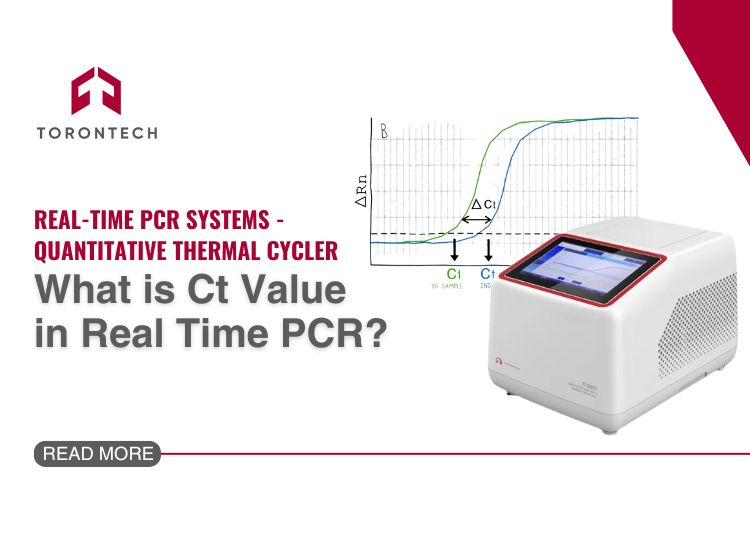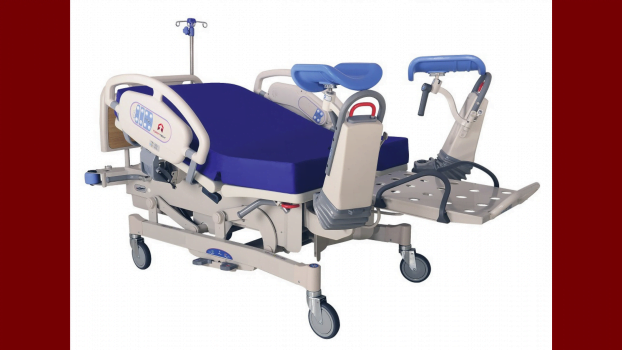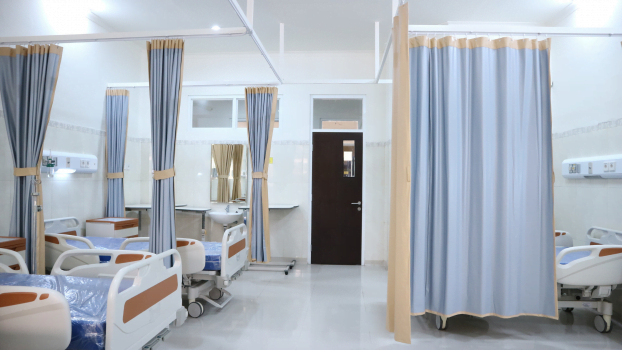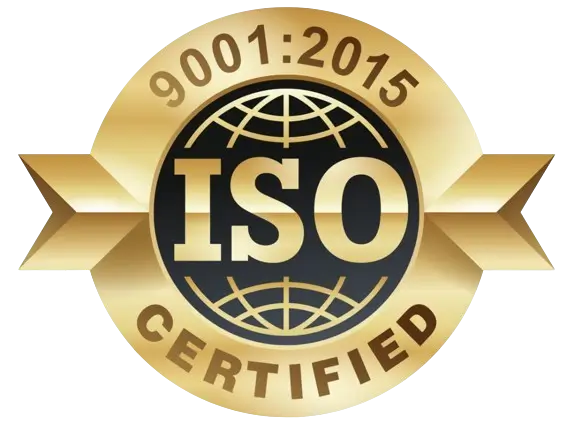If you’ve worked with real-time PCR (qPCR), you’ve likely come across the term Ct value, and for good reason. It’s the cornerstone of this technology, helping you interpret your results with precision.
Whether you’re diagnosing pathogens, studying gene expression, or working on a research project, understanding Ct values can give you the insights you need to succeed. Let’s break it down together.
What is Ct Value?
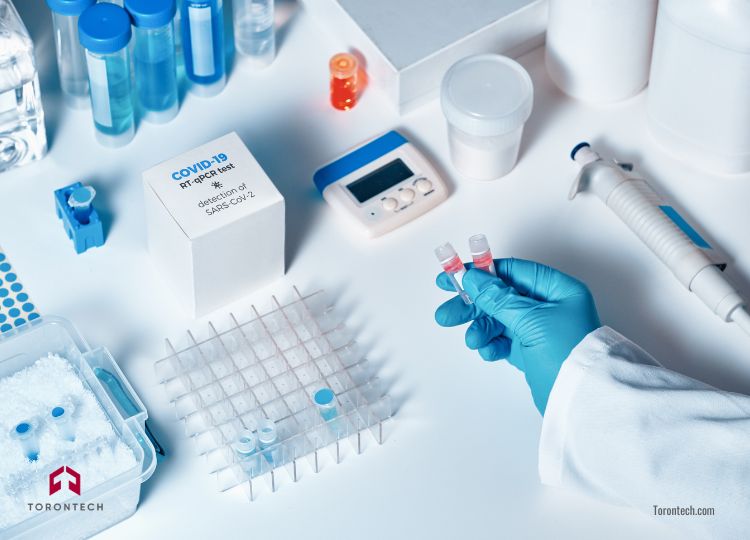
The Ct value (Cycle Threshold value) tells you how many amplification cycles it takes for your target DNA or RNA to generate enough fluorescence to cross a set threshold.
- Low Ct values (e.g., 15-20): Signal a high concentration of the target.
- High Ct values (e.g., 35-40): Indicate a lower concentration or even an absence of the target.
Think of it as a reflection of your sample’s starting material. A higher target concentration means fewer cycles are needed for detection, while a lower concentration takes longer.
Ct values are determined during the exponential phase of the PCR process, where amplification efficiency is at its peak. This ensures reproducibility, as the exponential phase offers consistent amplification unaffected by reactant depletion (Yuan et al., 2006).
How You Can Determine Ct Values?
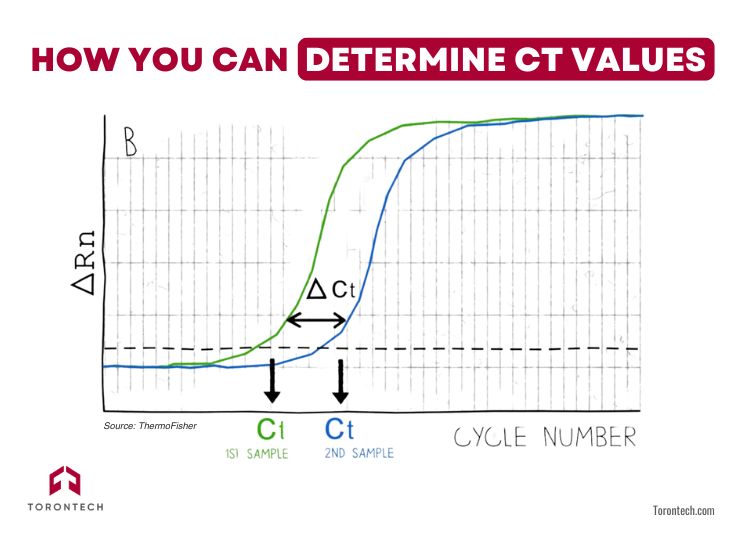
When you run a qPCR experiment, the data is displayed as an amplification plot. This graph shows fluorescence (signal) on the vertical axis and cycle numbers on the horizontal axis. Here’s how it works:
- Baseline Phase: In the early cycles, your fluorescence stays flat. The target might be amplifying, but the signal is too faint to detect.
- Exponential Phase: As the reaction progresses, fluorescence increases sharply. This is when the signal becomes detectable and crosses the threshold.
- Ct Value: The cycle number where your amplification curve crosses the threshold is the Ct value. This is the point you need for accurate quantification.
The threshold is set in the exponential phase, where amplification is most reliable. According to Thermo Fisher Scientific (2012), setting thresholds correctly minimizes variability and ensures precise Ct value determination across wells in a real-time PCR system.
How You Can Use Ct Values
Ct values aren’t just numbers, they’re important metric that help you draw meaningful conclusions from your data:
1. Qualitative Assays
Want to know if a pathogen is present? A Ct value tells you whether the target was detected in your reaction. No Ct value? That means no target was found. A lack of Ct value means no target detection, while its presence confirms amplification (Thermo Fisher Scientific, 2012).
2. Quantitative Assays
Need precise measurements? Ct values can be converted into quantities using equations like the ΔΔCt method. Quantitative methods are widely used for gene expression studies and pathogen quantification. This method normalizes Ct values using control genes and calibrators, ensuring biological relevance (Rao et al., 2021).
What Affects Your Ct Values
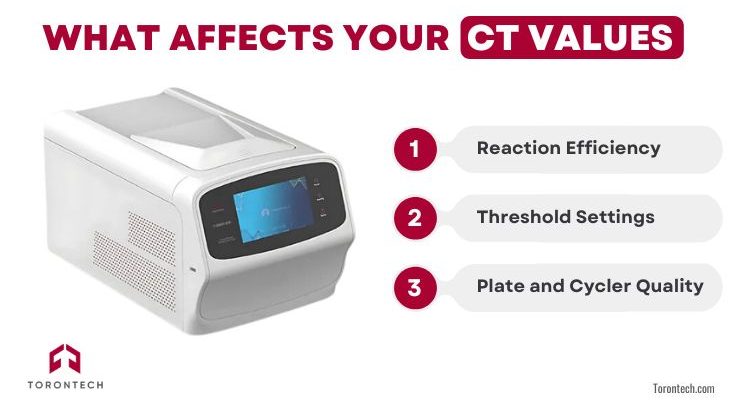
Several factors can influence your Ct values:
- Reaction Efficiency: Efficiency should ideally be 100%, where the target doubles in each cycle (Yuan et al., 2006). Suboptimal efficiency leads to inconsistent Ct values and unreliable data.
- Threshold Settings: Setting the threshold too low can pick up noise, while setting it too high might miss the exponential phase. The right balance ensures accuracy. Thermo Fisher Scientific (2012) emphasizes the importance of setting thresholds within the exponential phase to ensure precise Ct value determination.
- Plate and Cycler Quality: Poor-quality plates or an uncalibrated thermal cycler can introduce variability. Regular maintenance makes a big difference.
Tips for Reliable Results
Want to nail your Ct values every time? Follow these tips:
- Optimize Your Assays: Use validated reagents and double-check your primer designs.
- Keep Equipment in Top Shape: Regularly calibrate your thermal cycler and inspect your PCR plates.
- Set Clear Thresholds: Ensure your thresholds are in the exponential phase of the amplification curve for consistency.
- Normalize Your Data: Use control genes and calibrators to account for variations in sample preparation or reaction efficiency.
Why Ct Values Matter to You
The Ct value is more than just a number, it’s your key to understanding what’s happening in your samples. Whether you’re diagnosing diseases or conducting gene expression studies, reliable Ct values ensure your data is both accurate and actionable.
By paying attention to the details and using the right tools such as Real-Time PCR Machine, you can trust your qPCR results to guide your decisions, whether you’re diagnosing diseases, studying genes, or developing innovative solutions. After all, precision in the lab starts with you, and the Ct value is your trusted guide.
Frequently Asked Question (FAQ)
2. What is the business impact of setting the amplification threshold incorrectly in our qPCR assays?
Setting the threshold incorrectly can have serious business consequences. If it's set too low, you risk picking up background noise and generating false positives, which can trigger unnecessary downstream actions or investigations. If it's too high, you might miss true positives with low target concentrations, compromising the sensitivity of your assay. At Torontech, we emphasize proper training on this crucial step because we know that precise, automated threshold setting, a key feature of our Real-Time PCR machines, is fundamental for generating the accurate, actionable data your business depends on.
3. How does our choice of Real-Time PCR machine directly influence the quality of our Ct value data?
Your qPCR machine is the heart of your analysis, and its quality directly impacts your data. Factors like thermal uniformity across the block, optical sensitivity, and the quality of the analysis software are critical for generating consistent and reliable Ct values. A poorly calibrated or low-performance cycler can introduce variability that masks true biological differences in your samples. Investing in a high-performance system, like the ones we provide at Torontech, is an investment in data integrity, ensuring that the Ct values you generate are a true reflection of your samples, not a limitation of your hardware.
4. In our competitive R&D environment, how can a deep understanding of Ct values accelerate our projects?
In R&D, a deep understanding of Ct values is a powerful strategic advantage. It allows your research team to move beyond simple presence/absence results and confidently quantify changes in gene expression or viral load with high precision. This enables faster, more accurate validation of drug targets, assessment of treatment efficacy, or development of new diagnostic assays. By mastering Ct value interpretation with a reliable qPCR platform, your team can make quicker, data-driven decisions, shortening development cycles and accelerating your path to innovation.
5. We need to ensure our qPCR results are consistently reliable for quality assurance. How does Torontech support this goal?
Ensuring consistent reliability for QA is our top priority. We support this goal by providing more than just an instrument. First, we engineer our Real-Time PCR machines for exceptional performance and reproducibility. Second, our team works with you to ensure your assays are optimized and your staff is fully trained on best practices, from setting thresholds correctly to performing routine maintenance. We see ourselves as your partner in achieving data excellence, because we know that in quality assurance, there is no room for doubt in your results.
References
- Jarvis, N. A., O’Bryan, C. A., Dawoud, T. M., Crandall, P. G., & Ricke, S. C. (2011). Selection of a cutoff value for real-time polymerase chain reaction results to reduce false-positive results in the detection of Salmonella in meat and carcass samples. Journal of Veterinary Diagnostic Investigation, 23(1), 55-61. https://doi.org/10.1177/104063871102300102
- Rao, S. N., Manissero, D., Steele, V. R., & Pareja, J. (2021). A systematic review of the clinical utility of cycle threshold values in the context of COVID-19. Diagnostics, 11(6), 1091. https://doi.org/10.3390/diagnostics11061091
- Thermo Fisher Scientific. (2012). Real-time PCR: Understanding Ct. [Application Note]. Retrieved from https://assets.thermofisher.com/TFS-Assets/LSG/Application-Notes/cms_053906.pdf
- Yuan, J. S., Reed, A., Chen, F., & Stewart, C. N. (2006). Statistical analysis of real-time PCR data. BMC Bioinformatics, 7, 85. https://doi.org/10.1186/1471-2105-7-85

